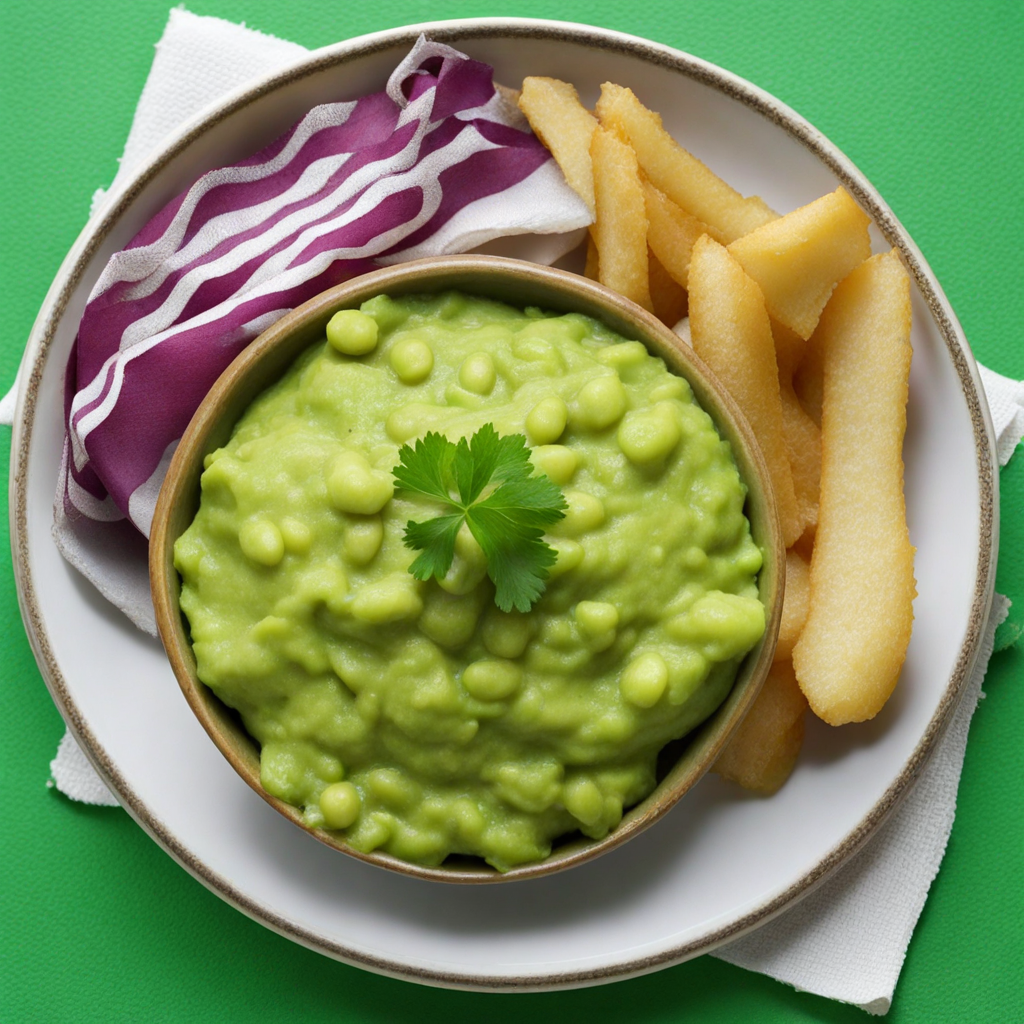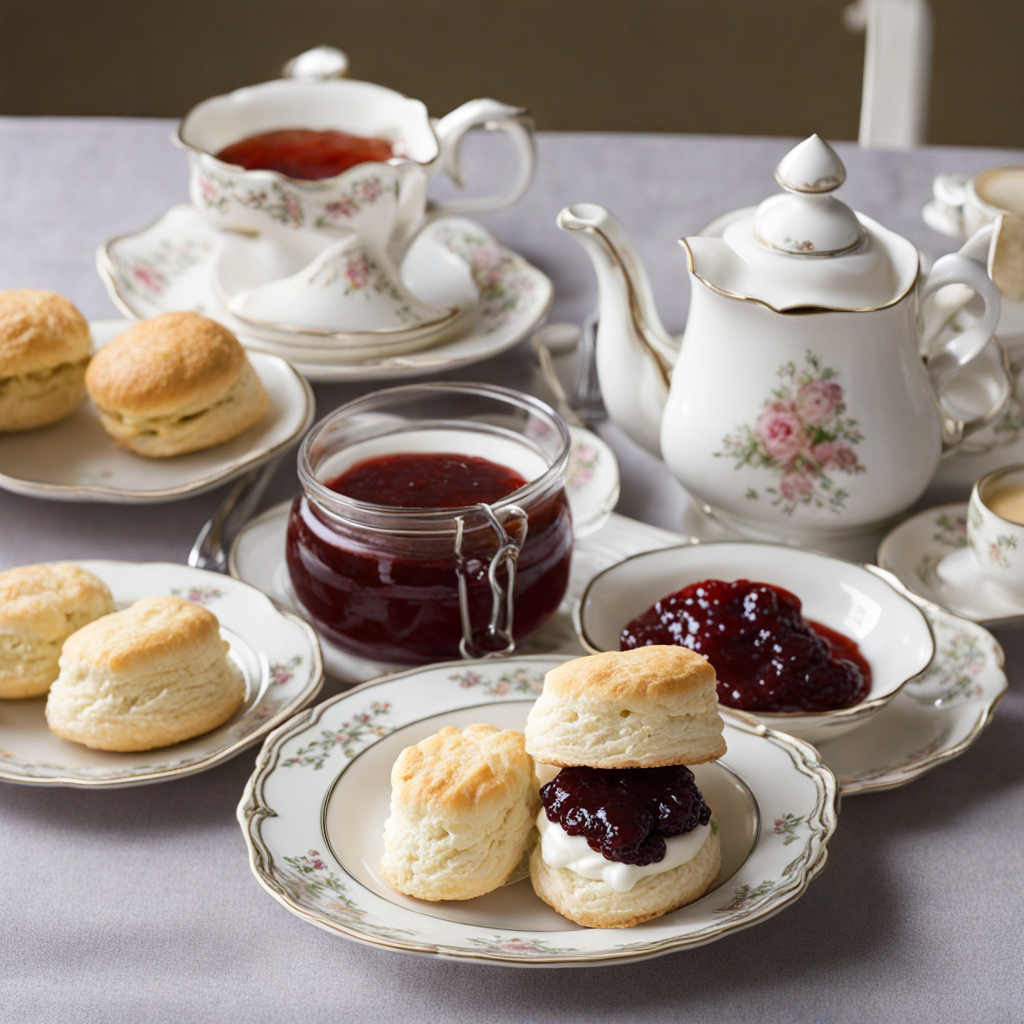Mushy Peas
Mushy peas are a classic British dish that embodies the rustic charm of traditional English cuisine. Typically made from marrowfat peas, they are soaked overnight and then slowly simmered until they reach a soft, creamy consistency. The result is a vibrant green mash that is both comforting and satisfying. The flavor profile is mild and earthy, allowing the natural sweetness of the peas to shine through, often enhanced by a touch of salt and a hint of mint, which adds a refreshing note to the dish. Traditionally served as a side, mushy peas are a staple accompaniment to fish and chips, where their creamy texture contrasts beautifully with the crispy batter of the fish. They can also be enjoyed alongside meat pies, sausages, or even as a hearty filling in sandwiches. The dish is not only a source of comfort but also a nod to the working-class roots of British cuisine, showcasing how simple ingredients can be transformed into something delightful and memorable. In recent years, mushy peas have gained a new following, with chefs experimenting by incorporating modern flavors and textures. Variations might include adding garlic, lemon zest, or even a drizzle of olive oil for a gourmet twist. Whether enjoyed in their traditional form or reinvented, mushy peas remain a beloved comfort food that resonates with both nostalgia and innovation, making them a must-try for anyone looking to explore the rich tapestry of British culinary delights.
How It Became This Dish
The History of Mushy Peas: A Culinary Journey through the United Kingdom Mushy peas, a beloved dish in British cuisine, often evoke nostalgia and a sense of comfort. Their vivid green color and unique texture have earned them a place alongside traditional British fare, particularly fish and chips. But the journey of mushy peas from humble beginnings to their status as a culinary staple is a fascinating tale that intertwines agricultural practices, regional identity, and cultural significance. Origins: The Pea and Its Place in British Agriculture The story of mushy peas begins with the pea itself, a crop that has been cultivated for thousands of years. While the exact origin of the pea is shrouded in mystery, archaeological evidence suggests that peas may have been grown in the Near East as early as 7000 BCE. They later spread throughout Europe, becoming a common food source by the Middle Ages. In the United Kingdom, the cultivation of peas took root as a staple of the British diet, particularly in the cooler, wetter climates of England. By the 16th century, various pea varieties were being grown, with the marrowfat pea emerging as a favorite for its starchy texture and ability to withstand the British climate. It is this specific type of pea that would ultimately become synonymous with mushy peas. The Birth of Mushy Peas The concept of 'mushy peas' as we know them today can be traced back to the 19th century, though the dish itself likely existed in some form long before that. The Victorian era marked a time of significant social and economic change in Britain, with the rise of industrialization leading to urbanization and the birth of the working class. Traditional meals often consisted of simple, hearty ingredients that could sustain laborers through long hours, and peas, particularly when dried and reconstituted, were an economical choice. Mushy peas were initially prepared by simmering dried marrowfat peas in water until they softened and then mashing them to achieve a creamy consistency. They were often seasoned with salt and pepper, and sometimes a touch of butter or mint was added for flavor. This process not only made the peas palatable but also enhanced their digestibility, making them an ideal food for the working class. Cultural Significance: A Symbol of British Identity Mushy peas quickly became popular in the northern regions of England, particularly in Yorkshire and Lancashire. Their association with fish and chips, a dish that rose to prominence in the late 19th century, solidified their place in British culinary culture. As fish and chips shops proliferated, especially in industrial towns, mushy peas became a standard accompaniment, enhancing the meal with their vibrant color and creamy texture. The pairing of mushy peas with fish and chips is much more than a mere culinary coincidence. It reflects a broader narrative about British identity and the working class. The dish became a symbol of comfort and sustenance for those who toiled in factories and mills. It represented a connection to the land, a reminder of simpler times when fresh, locally sourced ingredients were a way of life. Moreover, mushy peas have maintained a prominent role in British culture. They feature in popular media, from films to music, often evoking feelings of nostalgia and national pride. For many Brits, mushy peas are not just a side dish; they are a reminder of family gatherings, seaside trips, and the warmth of home-cooked meals. The Development Over Time As the 20th century unfolded, mushy peas went through various transformations. The advent of convenience foods and the rise of the frozen food industry in the post-war era changed the way peas were consumed. Frozen mushy peas became a popular option for busy families, offering the same nostalgic taste with less preparation time. The dish was no longer confined to fish and chips shops; it found its way into homes across the country. In recent years, however, there has been a resurgence of interest in traditional British foods, spurred by the broader movement towards sustainability and local sourcing. Chefs and home cooks alike have sought to elevate mushy peas, experimenting with flavors and presentation. Variations have emerged, such as adding garlic, lemon, or fresh herbs to give the classic dish a modern twist. Some chefs have even taken to serving mushy peas as part of gourmet dishes, showcasing their versatility beyond the traditional pairing. Mushy Peas in Contemporary Culture Today, mushy peas continue to occupy a unique space in British cuisine. They are a staple in traditional fish and chip shops and are often served at pubs and restaurants throughout the country. Their appeal extends beyond their flavor; they represent a connection to British heritage and culinary history. Social media has played a significant role in the revival of interest in mushy peas. Food bloggers and influencers have embraced the dish, sharing their own takes on the classic recipe and promoting its status as a comfort food. Additionally, the rise of “British food revival” movements has brought mushy peas back into the spotlight, with chefs highlighting their use of locally sourced ingredients and celebrating regional dishes. Moreover, mushy peas have transcended cultural boundaries. As British cuisine gains recognition worldwide, the dish has begun to appear on menus in international restaurants, often as a novelty or homage to British culinary traditions. This globalization of mushy peas speaks to the dish's enduring appeal and ability to adapt to contemporary tastes. Conclusion: A Culinary Legacy In essence, mushy peas are more than just a simple side dish; they encapsulate a rich tapestry of British history, culture, and identity. From their humble beginnings as a working-class staple to their modern reinterpretations, mushy peas represent resilience, nostalgia, and the enduring power of food to connect people. As they continue to evolve alongside societal changes, one thing remains clear: mushy peas will forever hold a cherished place in the hearts—and on the plates—of the British people.
You may like
Discover local flavors from United Kingdom







